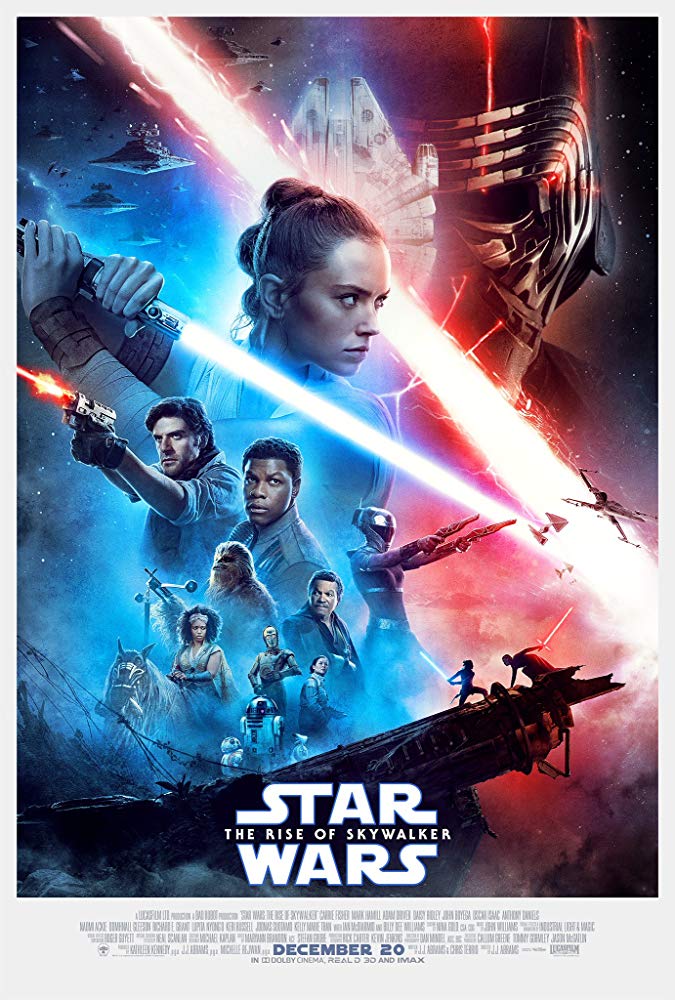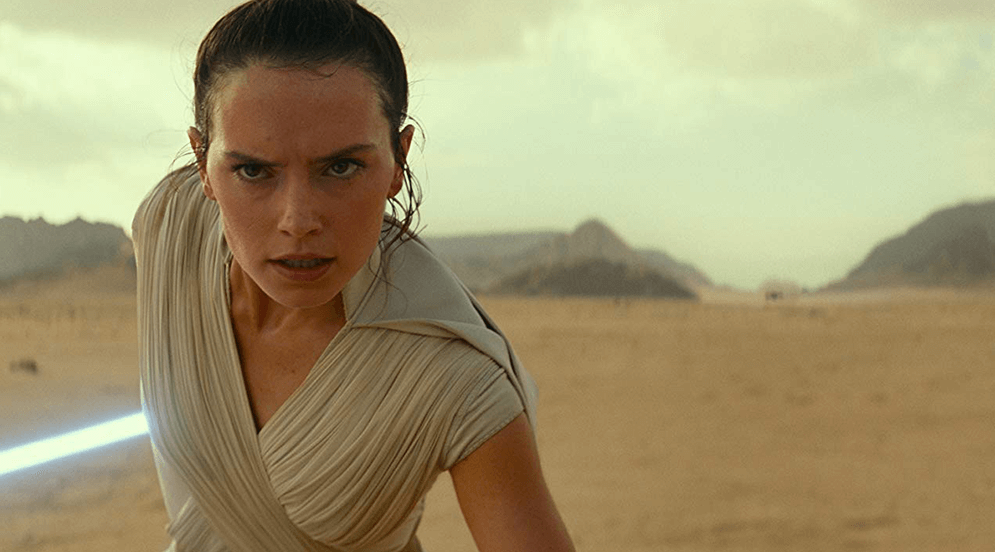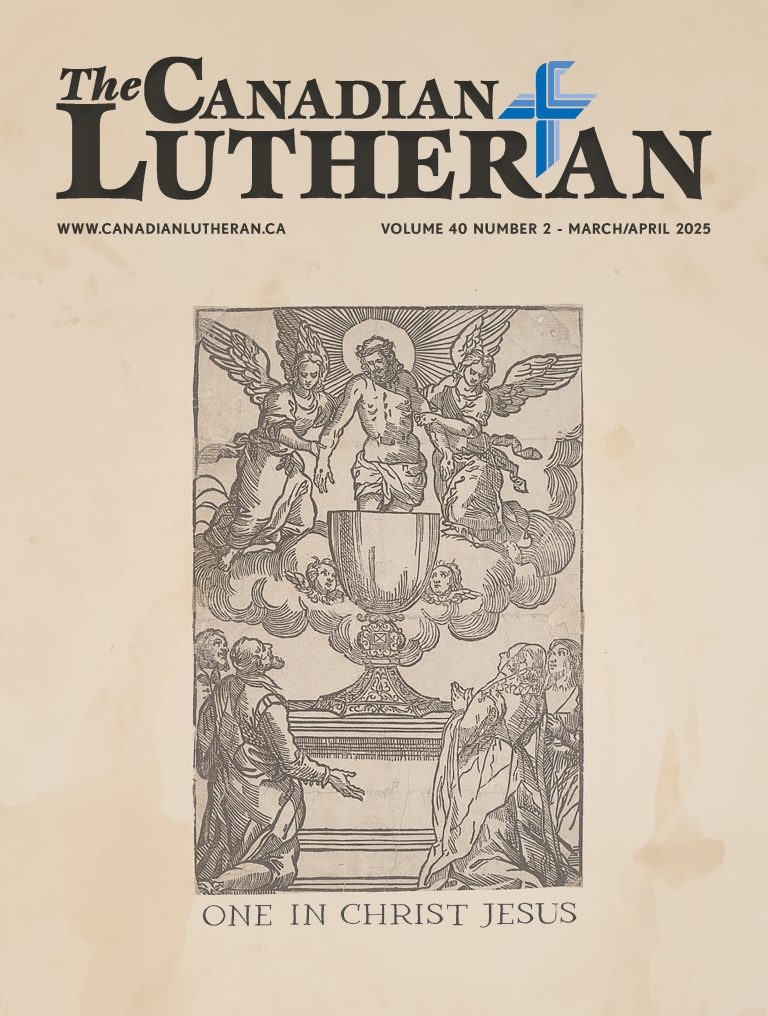Abrams’ End to the Star Wars Saga

Abrams’ End to the Star Wars Saga
By Ted Giese
As The Rise of Skywalker opens, General Leia Organa and her beleaguered Resistance are foiled, and find themselves attempting to stay alive to fight another day. The First Order grips the universe in a blanket of paralyzing fear as its new Supreme Leader, Kylo Ren—Leia’s estranged son—seeks to eliminate a phantom menace from the past: a long-thought-dead yet mysteriously alive Emperor Palpatine. Tempted by Palpatine’s offer of a new secret fleet of Star Destroyers mounted with Death Star-style weapons along with the promise of the throne of a new Galactic Empire, Kylo Ren agrees to hunt down Rey who is desperately trying to complete her Jedi training with the help of Leia. News of Palpatine and his secret fleet prompts the Resistance to make a last ditch attempt to stop Palpatine’s Final Order before it can merge with Ren’s First Order. Along the way old and new friends join Rey, Finn, Poe Dameron, Chewbacca, C-3PO, and the rest of the Resistance as questions about Rey’s lineage are answered, storylines are resolved, and Palpatine is confronted one last time.
On one hand, Rian Johnson’s The Last Jedi had painted Star Wars into a corner perhaps best epitomized by Kylo Ren when he says, “Let the past die. Kill it, if you have to.” On the other hand, J.J. Abrams reveres Star Wars’ past and is not interested in letting it die. Audiences first saw this in The Force Awakens and they see it again in The Rise of Skywalker. While The Force Awakens borrowed heavily from the first film, this new film borrows heavily from The Return of the Jedi. (Some viewers will see this as an homage full of respect while others will judge it uninspired). Abrams was considered a safe pair of hands to direct this final episode and while he made some bold story choices many of them are raked back quickly to please competing old and new fan bases.
The death of Leia in The Rise of Skywalker was almost inevitable following the actual death of Carrie Fisher in 2016. Using unused footage from the first two Disney films, Abrams constructed a composite CGI-enhanced performance which looks to be about as good as they could do with what they had to work with. Leia’s death comes at a critical moment and contributes to the redemption of her son Kylo Ren/Ben Solo.
Christian viewers were eagerly anticipating that redemption, and Abrams doesn’t disappoint. Han Solo appears to his son as a kind of vivid memory, and Kylo Ren relives the moments and words spoken between them in The Force Awakens. But now Ben Solo re-emerges. In an act of repentance, Ben throws his iconic angry crackling red Sith lightsaber into the depths of the sea. Christians may see in this act an almost biblical description of God’s forgiveness.
“[The LORD] will again have compassion on us; He will tread our iniquities underfoot. [He] will cast all our sins into the depths of the sea” (Micah 7:19).
Ben Solo now sees with new eyes his father’s compassion towards him—how Han had originally come to Star Killer Base, treading underfoot the iniquities of Kylo Ren to get to his real son and redeem him. Elements of Han and Ben’s relationship in the Disney trilogy echo biblical elements of King David with his son Absalom. But where David never had the opportunity to reconcile with Absalom, Abrams gives Han this opportunity with Ben. Had Carrie Fisher not died in 2016, Abrams would likely have had this reconciliation happen between mother and son. But the encounter with the memory of his father gives Ben the strength necessary to do the thing he knows is right. While not perfectly executed, this is one of the most satisfying character arcs in the Disney trilogy. Ben Solo then becomes an asset to Rey in the film’s final act as she squares off against Palpatine.
While Ben Solo’s character arc is satisfying, the emotional elements in the rest of the film are uneven. As a result of the previous film’s splitting up of major characters, it is difficult to believe—as this film requires in parts—that they are all close friends, willing to lay down their lives for each other. This has the effect of flattening much of the emotional landscape of The Rise of Skywalker—especially when characters like C-3PO look at Rey, Fin, and Poe (in the absence of R2D2 and Chewbacca) and say “I’m just taking one last look at my friends.” Even so, the film does a lot to create a sense of growing camaraderie between the characters.

The underdeveloped friendships in the trilogy contribute to an overall lack of tension and urgency in this film. Abrams raises the stakes in many places, but it’s hard to completely embrace the jeopardy or worry about the characters because of a seeming hollowness in the friendships. As a result some of the moments along the way feel unearned. This is, of course, a subjective criticism; but audiences who think on the relationships of the characters will see that more could have been done to develop the friendships between Rey, Fin, and Poe, especially when compared to the friendships of Luke, Leia and Han from the original trilogy. Ridley, Boyega, and Isaac do their best with thinly written characters.
In an odd way, Abrams succeeds at making a film that feels like those outlandish 1930s Flash Gordon serials full of whiz-bang effects and cliff hangers which were high on intensity and low on character development and real drama. Lucas on the other hand, while inspired by those early sci-fi serials, in a way failed to fully capture their spirit because he injected true drama and—by the end of his trilogy—well-rounded characters, in effect elevating the entire genre. With Abrams and Disney, the closest they come to this elevation is with the redemption of Ben Solo, which is positioned as a B-plot in The Rise of Skywalker. By contrast, the redemption of Anakin Skywalker in The Return of the Jedi through the persistent hope of his son Luke overshadows Emperor Palpatine’s continued desire for galactic dominion in that film, making his redemption narrative the true A-plot of the original trilogy.
Perhaps the distinction between the two trilogies is a good thing. The Disney trilogy, and Lucas’ own prequel trilogy, even with their advanced special effects and CGI, must respectfully bow to Lucas’ original trilogy, failing to outshine the true heart and soul of Star Wars.
With another solid score from composer John William and some spectacular visuals, many will find The Rise of Skywalker satisfying. In some significant ways it’s a return to form and shows greater respect for what came before it. Others will find fault with the film’s sheer goofiness: from the silly scavenger hunt plot, to the cascading series of plot conveniences, to the puzzling and campy final confrontation between Rey and Palpatine, to the awkwardly executed Rey/Ben romantic kiss. At times it was almost like Disney said, “People liked Avengers: Endgame let’s do something like that,” forgetting that Star Wars is its own thing. The Star Wars moments in The Rise of Skywalker are good, like chocolate chips, but they are like chocolate chips in a chocolate chip cookie. There is just a lot of additional stuff crammed into this manic madcap film about which fans will disagree.
Then there is the lesbian kiss. The film includes a superfluous, yet calculated, lesbian kiss between two unimportant characters—so superfluous it can (and has) been easily cut for release in Muslim countries without harming any aspect of the plot. Designed as a blink-and-you’ll-miss-it moment in the celebratory conclusion, it comes across as quintessential pandering—evidence that Disney doesn’t really care about, or has little to no actual conviction, concerning the LGBTQ social movement. If it did, the studio would have suffered the film to be banned in countries opposing same-sex relationships rather than cutting the scene.
Taken cynically, we might suggest that the kiss is included to virtue-signal to the left while knowing that the irritation it causes social conservatives would generate free publicity on both sides of the North American cultural spectrum in the form of thousands of articles and blogs and YouTube videos.
Disney sounds like it plans to leave the Skywalker story alone now for the time being, but the final scene suggests the possibility of continuing the Skywalker saga. Fans and casual viewers may need some time to process the Disney Star Wars trilogy and how it fits into the bigger story. While enjoyable and a great improvement over Johnson’s The Last Jedi, Abrams’ The Rise of Skywalker feels like a Cliff Notes Star Wars manic fever dream—or maybe something like a Star Wars comic slapped onto the big screen. Disney may at times be a bit ham-fisted with its nostalgia but it is quite adept at nostalgia in general. After all, they’ve built a Magic Kingdom on it. When Disney thinks the Skywalker saga will be profitable again, audiences should be prepared for another ‘Rise of Skywalker.’
———————
Rev. Ted Giese is lead pastor of Mount Olive Lutheran Church, Regina, Saskatchewan, Canada; a contributor to The Canadian Lutheran, Reporter; and movie reviewer for the “Issues, Etc.” radio program. Follow Pastor Giese on Twitter @RevTedGiese.




